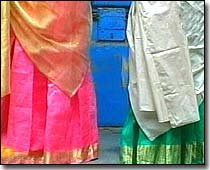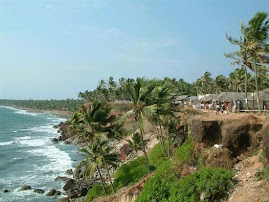Kerala is a state on the Malabar Coast of southwestern India. To its east and northeast, Kerala borders Tamil Nadu and Karnataka respectively; to its west and south lie the Arabian Sea and the Indian Ocean, with the islands of Lakshadweep and the Maldives, respectively. Kerala nearly envelopes Mahé, a coastal exclave of Pondicherry. Kerala is one of the four states of South India.
Sunday, October 21, 2007
Kerala
Kerala is a state on the Malabar Coast of southwestern India. To its east and northeast, Kerala borders Tamil Nadu and Karnataka respectively; to its west and south lie the Arabian Sea and the Indian Ocean, with the islands of Lakshadweep and the Maldives, respectively. Kerala nearly envelopes Mahé, a coastal exclave of Pondicherry. Kerala is one of the four states of South India.
Friday, October 19, 2007
Traditional Women Costumes

Full Skirt and Long Blouse
The full skirt with long blouse that formed the traditional teenage dress of malayale girls is fast disappearing from the Kerala fashion scene. It however, is still worn by village girls though their counter parts in the city have slowly discarded it. On ceremonial occasions and festival days the long skirt with pleats and kasavu Boarder with front or back open blouse is worn.

Half Sari
With the advent of the North Indian fashion dress on a large scale in kerala, the half sari dress is seldom seen in any part of kerala. The half sari that was worn earlier consisted of a full skirt, short blouse and a davani (shawl) and sari blouse.
Mundu Set

The demand for the set mundu among the women of kerala contrary to general belief is in fact growing. It is a form of sari in two sets worn with a blouse. Used primarily on festival occasions like onam and vishu and for visiting temples, the set mundu is available in Sandal wood color or white color with silk border or colored border. It is worn in the same fashion of a sari, but without pleats in the front. Though initially intended as a ceremonial dresses in the ancient times it has however attained a position of being worn by both young and old on all occasions.
Now it is available in the same style of a sari as one piece and is known as Kerala Sari. It is worn in the same style of a sari with pleats in front. It has borders with thin or wide silk or ordinary colored ones. Along with the area of the silk border, the price of the sari too increases.
Sari

From very ancient times sari has been closely associated with the women of kerala and it still forms the major mode of dress even today. A 5 meter long cloth, It is worn together with a small blouse .It is however a tough job to learn to wear a sari in a proper manner and one needs to practice a lot.
Sari is the official dress in various ceremonies like wedding, engagement and during various festivals in kerala.
Thursday, October 18, 2007
Salwars in Kerala

Salwaar kameez
Though a north Indian dress the salwar kameez in kerala has become a craze among the younger generations. It’s acceptance is to a large extent due to its unique and outstanding styles and convenience. The comfort that salwar kameez provides has made it so popular that it is worn on formal and non formal occasions.
In kerala tradition always played a prominent part in the acceptance of every form of modern dress circulating in the country.
Lehnga

Lehnga is steeped in tradition and its history can be traced to the mughal royalty. Considered the apt dress on ceremonial occasions and worn by people of royal blood in olden days, lehngas come in many different styles. Lehangas are glamorous and elaborate. Rich fabrics such as silk, organza, jamewars and brocades have been used lavishly in lehengas. The creations are inspired by the timeless traditional motifs and contemporary patterns. The colors are bright in hues of reds, oranges, maroons, and gold. Considered to be the most appropriate feminine dress lehengas are available in a variety of sizes. It has become so popular in kerala that lehanga has replaced the traditional sari among a large chunk of the younger generations. It is also considered to be the best wear during the day and evening time.
Short Kurtis and long kurtis
Though a late entrant to the kerala fashions scene, the kurtas have captured the imagination and fashion demands of a large portion of the younger feminine folk.

The cut of the Kurta provides room for air to flow between the garment
 and your skin and Kurtas often feature the long sleeves you need to cover-up after a bout of sunbathing. What sets the garment apart is often the embroidery. Zardozi, traditional gold and silver wire embroidery has been superseded by plain thread embroidery to give the under-stated, yet elegant look for the daytime. Chikankari is a lovely work, which involves intricate shadow type of embroidery done on white yarn. The Kurti is unlikely to die. Trends may change, chikankari work may be superseded by phulkari and the style may push the boundaries with ever more transparent tunics, but when it comes to comfort, style, and sheer wear ability there is little to beat the humble Tunic.
and your skin and Kurtas often feature the long sleeves you need to cover-up after a bout of sunbathing. What sets the garment apart is often the embroidery. Zardozi, traditional gold and silver wire embroidery has been superseded by plain thread embroidery to give the under-stated, yet elegant look for the daytime. Chikankari is a lovely work, which involves intricate shadow type of embroidery done on white yarn. The Kurti is unlikely to die. Trends may change, chikankari work may be superseded by phulkari and the style may push the boundaries with ever more transparent tunics, but when it comes to comfort, style, and sheer wear ability there is little to beat the humble Tunic.http://www.keralafashions.com/
Wednesday, October 17, 2007
WEDDING WEAR
 The most common dress among the Hindu women is either a set and mundu or a colored sari. As the wedding day is considered one of the most important days of their life every effort is made to make this occasion truly memorable. Kanchepurum saris considered the finest in kerala is worn on this auspicious day Saris of other makes including those from silk, georgettes and crape are also worn. Bridal dresses presently come with Zari, embroidery, zardosi, sequence, cut work, mirror work, patchwork, pearl work, kasab and kundan that all add a touch of class and beauty to the the sari worn.
The most common dress among the Hindu women is either a set and mundu or a colored sari. As the wedding day is considered one of the most important days of their life every effort is made to make this occasion truly memorable. Kanchepurum saris considered the finest in kerala is worn on this auspicious day Saris of other makes including those from silk, georgettes and crape are also worn. Bridal dresses presently come with Zari, embroidery, zardosi, sequence, cut work, mirror work, patchwork, pearl work, kasab and kundan that all add a touch of class and beauty to the the sari worn.Christian
 The bridal dress worn by the Christian women is peculiar in that it is different from the dress worn by the Hindus and Muslim women. A Christian woman wears a purely white sari with a white veil on their head symbolizing purity. Nowadays designer made bridal gowns are also rather popular. Bridal gowns are traditionally of a single color, depending on our culture., brides wear white or ivory gowns.
The bridal dress worn by the Christian women is peculiar in that it is different from the dress worn by the Hindus and Muslim women. A Christian woman wears a purely white sari with a white veil on their head symbolizing purity. Nowadays designer made bridal gowns are also rather popular. Bridal gowns are traditionally of a single color, depending on our culture., brides wear white or ivory gowns.Muslim

Muslimwomen usually wear bright colored silk saris on their wedding days. The lehnga that was the traditional dress during the mughal period is also worn by a large number of Muslim women now. The dupatta is worn as a headdress along with this lehnga. This combination increases the visual beauty of the lehnga. The dupatta was made of a flimsy material and to give some more weight to the cloth, golden lace or tassels were attached to the ends.
Monday, October 15, 2007
Traditonal Full Skirt and Long Blouse
 nd Tamil Nadu. It is not seen very common now in cities and towns but usually worn by village girls.
nd Tamil Nadu. It is not seen very common now in cities and towns but usually worn by village girls.For, the pavada has almost vanished from the Malayali girl's wardrobe.
In Kerala, only th
 e `bold' wore the salwar kurta two decades ago. And then came the invasion of the electronic media and salwar kurtas found their way into the hearts of Malayali girls.
e `bold' wore the salwar kurta two decades ago. And then came the invasion of the electronic media and salwar kurtas found their way into the hearts of Malayali girls.

For more details visit
http://www.hinduonnet.com/thehindu/mp/2003/11/13/stories/2003111301410300.htm
http://www.keralafashion.com/salwar.htm
Saturday, October 13, 2007
Traditional Half Saree
 pecific. It exclusively belongs to young women and no woman past her teens would usually wear it.The half-saree marks a sartorial transition from girlhood to womanhood. It combines the impishness of a girl with the feminine grace of a young woman.That is one reaso
pecific. It exclusively belongs to young women and no woman past her teens would usually wear it.The half-saree marks a sartorial transition from girlhood to womanhood. It combines the impishness of a girl with the feminine grace of a young woman.That is one reaso n perhaps why south Indian filmmakers are rediscovering the half-saree, giving the garment a fresh lease of life.
n perhaps why south Indian filmmakers are rediscovering the half-saree, giving the garment a fresh lease of life.Half Saree was very common among young girls of Kerala and Tamil Nadu. Full skirt, short blouse and a davani (shawl) constitutes this dress style.

It is considered to be originated in Tamil Nadu, but is very commonly used in Kerala till about 30 years back. Nowadays with all modern fashions half saree is almost completely diappeared among Kerala girls.
Photo Gallery


For more details visit
http://www.thechennaisilks.com/
Description
Green and maroon color pure silk pavada davani (half saree) with rich zari woven border and pallu.

Description
Pink and maroon color pure silk pavada davani (half saree) with rich zari woven border and pallu embellished with zardosi, sequins and kundan work.
+with+beautiful+scalloped+border..bmp) Description
Description
Peach and maroon color silk pavada davani (half saree) with beautiful scalloped border.
Description
Orange and deep maroon color pure silk pavada davani (half saree) with rich zari woven border and pallu embellished with zardosi, sequins and kundan work.

Description
5Blue and green color pure silk pavada davani (half saree) with rich zari woven border and pallu embellished with zardosi, sequins and kundan work.

Description
6White and maroon color pure silk pavada davani (half saree) with rich zari woven border and pallu embellished with zardosi, sequins and kundan work. Description
Description
Green and orange color pure silk pavada davani (half saree) with rich zari woven border and pallu embellished with zardosi, sequins and kundan work.
Description
Dark red and yellow color pure silk pavada davani (half saree) with rich zari woven border and pallu embellished with zardosi, sequins and kundan work.
Description
Purple and light olive color pure silk pavada davani (half saree) with rich zari woven border and pallu embellished with zardosi, sequins and kundan work
Actresses in Beautiful Half Saree









+with+rich+zari+woven+border+and+pallu..bmp)






